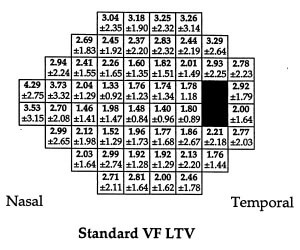Blumenthal EZ, Sample PA, Zangwill L, Lee AC, Kono Y, Weinreb RN.
Am J Ophthalmol. 2000 Mar;129(3):309-13.
Glaucoma Center and Visual Function Laboratory, Department of Ophthalmology, University of California, San Diego, CA, USA.
ABSTRACT:
PURPOSE: To quantify and compare, on a point-by-point basis, the long-term variability of standard and short-wavelength automated perimetry in a group of stable glaucoma patients.
METHODS: From a group of 53 glaucoma patients experienced in visual field testing, we identified one eye, randomly chosen, from each of 25 glaucoma patients whose condition was found to be stable, based on both standard and short-wavelength automated perimetry visual field criteria. On each of three visits during a period of up to 3 months, each patient performed one standard and one short-wavelength automated perimetry 24-2 visual field in a random order on a Humphrey visual field analyzer. The long-term variability (also referred to as test-retest variability) was defined as the SD of the three threshold decibel values at each test location. The long-term variability for each test point (mean +/- SD) was determined separately for both standard visual fields and short-wavelength automated perimetry.
RESULTS: With all 52 test locations of the 24-2 field averaged, the global long-term variability, mean (+/- SD) for standard visual fields and short-wavelength automated perimetry was 2.37 +/- 2.03 dB (95% confidence interval, 2.26-2.48 dB) and 2.92 +/- 2.03 dB (95% confidence interval, 2.81-3.03 dB), respectively (P <.0001). In 16 of the 52 visual field locations, long-term variability on short-wavelength automated perimetry was significantly higher than long-term variability on standard visual fields. In addition, the long-term variability increased with greater distance from the point of fixation for both standard visual fields and short-wavelength automated perimetry. The long-term variability decreased closer to fixation, more for standard visual fields than for short-wavelength automated perimetry.
CONCLUSIONS: In a group of stable glaucoma patients, mean long-term variability was 0.55 dB higher for short-wavelength automated perimetry than for standard visual fields. This needs to be taken into consideration when serial visual fields are evaluated for change
Figure from this article:


